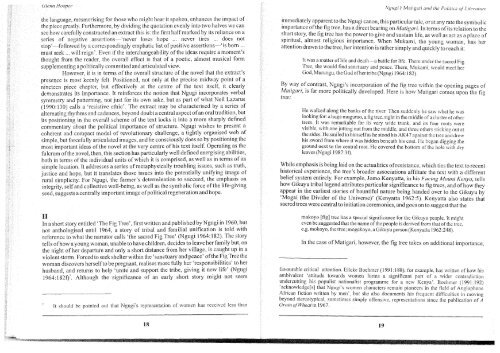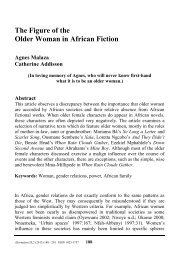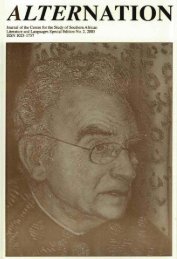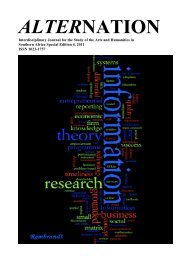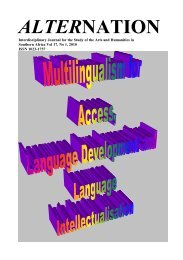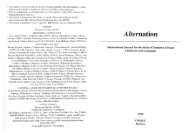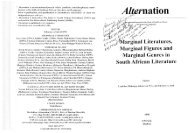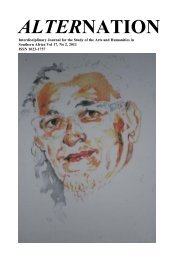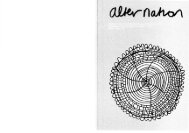Shane Moran - Alternation Journal
Shane Moran - Alternation Journal
Shane Moran - Alternation Journal
You also want an ePaper? Increase the reach of your titles
YUMPU automatically turns print PDFs into web optimized ePapers that Google loves.
nn Hooper<br />
tlie language, ~nesmerising for those wlio ~n~ght hear it spoken, enhalices the nnpact of<br />
the piece greatly. Furthermore, by dividing the quotation evenly into two halves we can<br />
see how carefully constructed an extract this is: the first half markedby ~ ts reliance on a<br />
series of negative assertions-'never loses hope ... never tires . . does not<br />
stop'-followed by a correspondingly emphatic list of positive assertions--'is born . .<br />
tnust seek ... will reign'. Even if the interchangeability of the ideas require a moment's<br />
thought from the reader, the overall effect is that of a poetic, alinost musical form<br />
supplemetlting a pol~tically committed and articulated view.<br />
However, it is in terms of the overall stntcture of the novel that the extract's<br />
presence 1s tnost keenly felt. Positioned, not only at the precise midway point of a<br />
nineteen piece chapter, but effectively at the centre of the text itself, it clearly<br />
demonstrates its importance. It reinforces the notion that Ngugi incorporates verbal<br />
symmetry and patterning, not just for its own sake, but as part of what Neil Lazarus<br />
(1990:130) calls a 'resistive ethic'. The extract may be characterised by a series of<br />
alternating rhythms and cadences, beyond doubt a central aspect of an oral tradition, but<br />
its positioning in the overall scheme of the text locks it into a more sharply defined<br />
colnlnentary about the political importance of structure. Ngugi wishes to present a<br />
coherent and compact model of revolutionary challenge, a tightly organised web of<br />
simple, but forcefully articulated images, and he consciously does so by positioning the<br />
most important ideas of the novel at the very centre of his text itself. Operating as the<br />
fulcrum ofthe novel, then, this section has particularly well defined energising abilities,<br />
both in terms of the individual units of which it is comprised, as well as in terms of ~ ts<br />
sirnple location. It addresses a series of ~netaphysically troubling issues, such as truth,<br />
justice and hope, but it translates those issues into the potentially unifying image of<br />
rural simplicity. For Ngugi, the farmer's determination to succeed, the emphasis on<br />
integrity, self and collect~ve well-being, as well as the sy~nbolic force of the life-giving<br />
seed, suggests a centrally important image of political regeneration and hope.<br />
I1<br />
In a short story entitled 'The Fig Tree', first written and published by Ngugi in 1960, but<br />
not anthologised until 1964, a story of tribal and familial unification is told with<br />
reference to what the narrator calls 'the sacred Fig Tree' (Ngugi 1964:182). The story<br />
tells ofhow a young woman, unable to have children, decidcs to leave her family but, on<br />
the night of her departure and only a short distance from her village, is caught up in a<br />
violent storm. Forced to seek shelter within the 'sanctuary and peace' ofthe Fig Tree the<br />
woman discovers herself to be pregnant, realises more fully her 'responsibilities' to her<br />
husband, and returns to help 'unite and support the tribe, giving it new life' (Ngugi<br />
1964:152Q7. Although the significance of an early short sto~y might not seem<br />
' It sliould be po~nted out that Ngugl's representation of women has rece~vcd less than<br />
irnrned~ately apparent to theNgugi canon, this part~cular tale, or at any rate the symbolic<br />
importance ofthe fig tree, has a direct bearing on Mutigari. In tenns of its relation to the<br />
short stoly, the fig tree has the power to give and sustain life, as well as act as a place of<br />
spiritual, almost religious Importance. When Mukar~ii, the young woman, has her<br />
attention drawn to the tree, her intention is rather simply and quickly to reach it:<br />
It was aniatter of life and deatli-a battle for life. There under tlie sacred Fig<br />
Tree, she would find sanctuary and peace. Thcre, Mukami. would meet her<br />
God, Murungu. the God of her tribe (Ngugi 1964: 182).<br />
By way of contrast, Ngugi's incorporation of the fig tree within the opening pages of<br />
Maligari, is far more politically developed. Here is how Matigari comes upon the fig<br />
tree:<br />
He walked along the banks of the river. Then suddenly he saw what he was<br />
looking for: ahuge mugumo. a fig tree, right in the middle of a cluster of other<br />
trees. It was rc~narkable for its very wide trunk. and its four roots were<br />
visible, with one jutting out from the middle. and three otliel-s sticking out at<br />
the sides. He smiled to himself as he stood his AK47 against the tree and drew<br />
his sword from where it was hidden beneath his coat. Ilc began digging tlie<br />
ground next to the central root. He covered the bottoni of tlle hole with dry<br />
leaves (Ngugi 1987:3Q.<br />
While emphasis is being laid on the actualities ofresistance, wh~ch ties the text to recent<br />
historical experience, the tree's broader associations affiliate the text with a different<br />
belief system entirely. For example, Jomo Kenyatta, in his Faczng Moz~nt finyu, tells<br />
how Gikuyu tribal legend attributes particular significance to fig trees, and of how they<br />
appear in the earliest stories of bountiful nature being handed over to the Gikuyu by<br />
'Mogai (the Divider of the Universe)' (Kenyatta 1962:5). Kenyatta also states that<br />
sacred trees were central to initiation ceremonies, and goes on to suggest that the<br />
mokoyo [fig] tree has a special sig~iikicance Sor the Gikuyu people. It ~nrght<br />
even be suggested that the name of the people is derived from that oftlie tree,<br />
e.g. mokoyo. the tree; mogekoyo. aGikuyu person (Kenyatta 1962:248).<br />
In the case of Matigari, however, the fig tree takes on additional importance,<br />
favourable critical attention. Elleke Boehmer (1 991 : 1 SS), for example, has written of how his<br />
ambivalent 'attitude towards women iorrns a significant pal-t of a wider contradiction<br />
undercutting his populist nationalist prograinme for a new Kenya'. Boehmer (1991:192)<br />
'acknowledge[s] that Ngugi's women characters remain pioneers in the field of Anglopllone<br />
African fiction written by men', but she also documents his fi-equent difficulties in moving<br />
beyond stereotypical, sometimes simply offensive, representations since the publicatioli of il<br />
GI-nin of PYhent in 1967.


